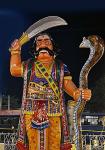- This match was India's 400th Test match. India became the fourth team after England (848), Australia (682) and West Indies (433) to appear in 400 Test matches.
- India's first innings total of 200 was their second lowest total in a match in the West Indies after electing to bat first. The 177 at Bridgetown in 1975-76 remains the lowest ever such total.
- Virender Sehwag (in the first innings) recorded the eighth duck of his Test career. Surprisingly, India have won 5 and lost only two of these games.
- Anil Kumble completed his 2,000 runs in Tests when his score reached 30 during his innings of 45 in the first innings. He completed the all-round double of 2,000 runs and 200 wickets, becoming only the second Indian after Kapil Dev and the 14th player in Test history to do so. Kumble, however, is only the second player to achieve the all-round double of 2,000 runs and 500 wickets after Australia's Shane Warne.
- With his knock of 81 in the first innings, Dravid established a new Indian record of scoring half-centuries in most consecutive Tests. This was the seventh consecutive Test in which Dravid has scored at least a fifty -- 71 at Nagpur, 95 at Mohali, 52 at Mumbai against England, 62 at St. John's, 146 at Gros Islet, 68 not out at St. Kitts and 81 here at Kingston against the West Indies. The previous Indian record was half-centuries in six consecutive Tests, shared by Vijay Hazare, Chandu Borde, Sunil Gavaskar, Dilip Vengsarkar (twice) and Sadagoppan Ramesh.
- West Indies' first innings total of 103 is their lowest ever against India at home or abroad. The previous lowest was 127 at Delhi in 1987-88. West Indies' previous lowest against India in the Caribbean was 140 at Bridgetown in 1996-97.
- The dismissal of Marlon Samuels in first innings was the 20th stumped wicket off the bowling of Kumble. With this, Kumble equalled Subhash Gupte's Indian record of dismissing most batsmen in this fashion. Interestingly, Dhoni has now effected six stumpings off Kumble in 13 Tests -- most by any Indian keeper. Nayan Mongia comes second with four stumpings.
- India managed to achieve a first innings lead of 97 runs despite scoring only 200. This is the second largest first-innings lead for a side scoring 200 or less in its first innings. The record is held by Australia, who were bundled out for 180, but managed to bowl out Pakistan for a paltry 62 at Perth in 1981-82 to take a lead of 118.
- Harbhajan Singh achieved his best figures in the Caribbean when he claimed 5 for 13 in 4.3 overs in the first innings. Harbhajan's strike-rate of 5.40 (balls per wicket) is the second best for any bowler in Tests taking at least five wickets in an innings. Australia's Ernest Toshack picked up 5 for 2 in just 19 balls (SR 3.80) at Brisbane in 1947-48 against India. More recently, South Africa's Jacques Kallis claimed 5 for 21 (also in 27 balls like-wise Harbhajan) against Bangladesh at Potchefstroom in 2002-03.
- India needed only 201 balls (legitimate) to dismiss West Indies in the first innings. There have been only three occasions when India needed even lesser balls to bowl out the opponents in an innings- England (102) in 158 balls at Mumbai in 1981-82, Bangladesh (124) in 160 balls at Chittagong in 2004-05 and Australia (93) in 185 balls at Mumbai in 2004-05.
- Dravid completed his 1,000 runs in Tests in the year 2006 when his score reached 22 in the second innings. He became the first batsman to do so this year. At the end of this match, Dravid's tally in 2006 reads as 1,046 runs in 18 innings of 10 Tests at an average of 74.71 with three hundreds and seven half-centuries.
- This is the second occasion that Dravid has aggregated 1,000 runs in a calendar year. In 2002, he had scored 1,357 runs in 16 Tests averaging 59.00.
- Dravid completed his 9,000 runs in Tests when his score reached 19 in the second innings. He became the sixth batsman to do so after Sunil Gavaskar, Allan Border, Steve Waugh, Sachin Tendulkar and Brian Lara.
- By taking only 176 innings to complete his 9,000 runs, Dravid also became the quickest in terms of least number of innings taken to accomplish this feat bettering Brian Lara's record who took 177 innings to aggregate 9,000 runs.
- Dravid became only the fourth batsman to score half-centuries in both innings of a Test, in which no other fifty was scored for India. Others to do so for India are -- Vengsarkar against England at Leeds in 1986, Tendulkar against Australia at Melbourne in 1999-00 and at Mumbai in 2000-01.
- Dravid achieved the two highest scores in the match. This provided only the seventh such instance in a Test, where all 40 wickets fell. He is the second Indian after Dilip Vengsarkar (102 not out and 61 against England at Leeds in 1986) to do so.
- Dravid has now top scored in a completed innings on 17 occasions while playing abroad. This puts him at level with Tendulkar. Now only little master Sunil Gavaskar (18) has top scored in a completed innings on more occasions for India than Dravid.
- Dravid's aggregate of 496 runs in the series is the highest by an Indian captain in an overseas series. He obliterated Sunil Gavaskar's record, who had aggregated 434 runs in six match series against Pakistan in 1982-83. The previous record of highest aggregate by an Indian captain away from the sub-continent was held by Mohammad Azharuddin, who aggregated 426 runs in five innings of a three match series against England in 1990.






